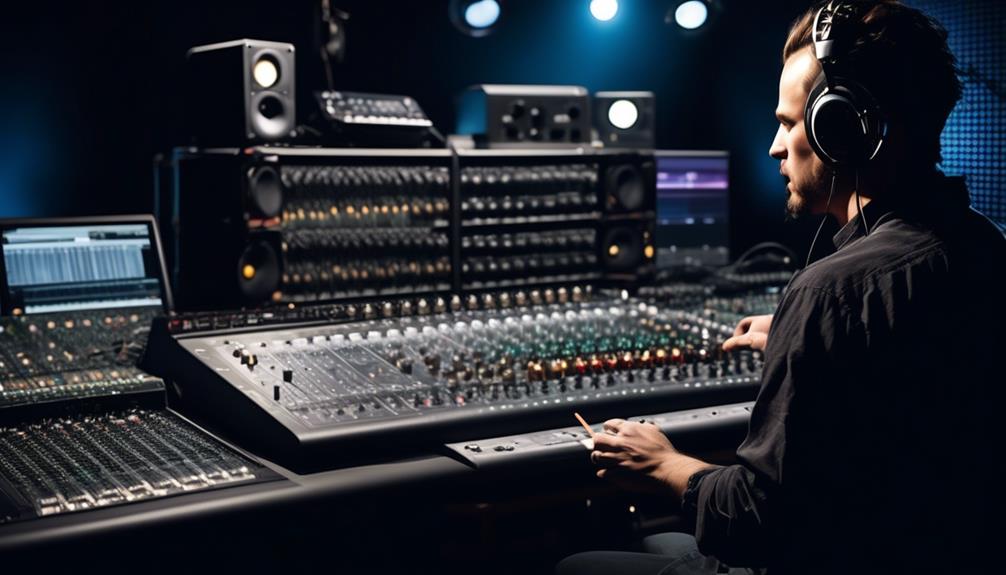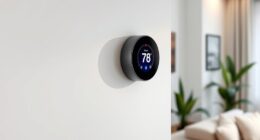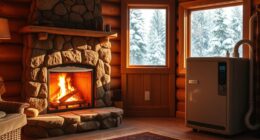We realize that the idea of making field recordings can be intimidating at first, particularly if you are worried about capturing top-notch sounds. Nonetheless, with the proper approach and equipment, field recording can turn out to be a fulfilling and enriching experience.
As we delve into the intricacies of this art form, we'll explore essential techniques, equipment selection, and location scouting to help you capture the essence of your surroundings.
Whether you're an audio enthusiast or a professional sound designer, field recordings can elevate your projects to new heights, allowing you to create immersive and captivating auditory experiences that resonate with your audience.
Key Takeaways
- Having the right equipment, including a field recorder, microphones, wind protection, and carrying cases, is crucial for high-quality field recordings.
- When selecting equipment, consider the environment and recording needs, looking for a recorder with high-quality preamps, XLR inputs, and durability. Investing in additional microphones and using wind protection can enhance the recording experience.
- Understanding microphone positioning, polar patterns, frequency response, and using filters to eliminate unwanted noise are essential for achieving diverse and immersive soundscapes.
- Location scouting and preparation, including researching potential recording locations, considering time of day and weather conditions, testing equipment on-site, and ensuring safety and legal compliance, are important steps in capturing unique and compelling field recordings.
Field Recording Fundamentals
Let's explore the essential principles of field recording.
When it comes to creating high-quality field recordings, having the right equipment is crucial. An audio recorder, also known as a field recorder, is the cornerstone of any field recording setup. These devices are designed to capture natural sounds and ambient noises with exceptional clarity and fidelity. Investing in a reliable field recorder is essential for anyone looking to capture high-quality field recordings.
In addition to the audio recorder, other field recording equipment plays a vital role in the process. High-quality microphones, wind protection, and carrying cases are all essential tools for capturing pristine audio in outdoor environments. Understanding how to position microphones to capture the best sound is also a fundamental skill for field recording.
To create high-quality field recordings, it's important to develop a deep understanding of the equipment and techniques involved. Mastery of field recording fundamentals will enable us to capture the purest and most immersive audio experiences from the natural world.
Selecting the Right Equipment
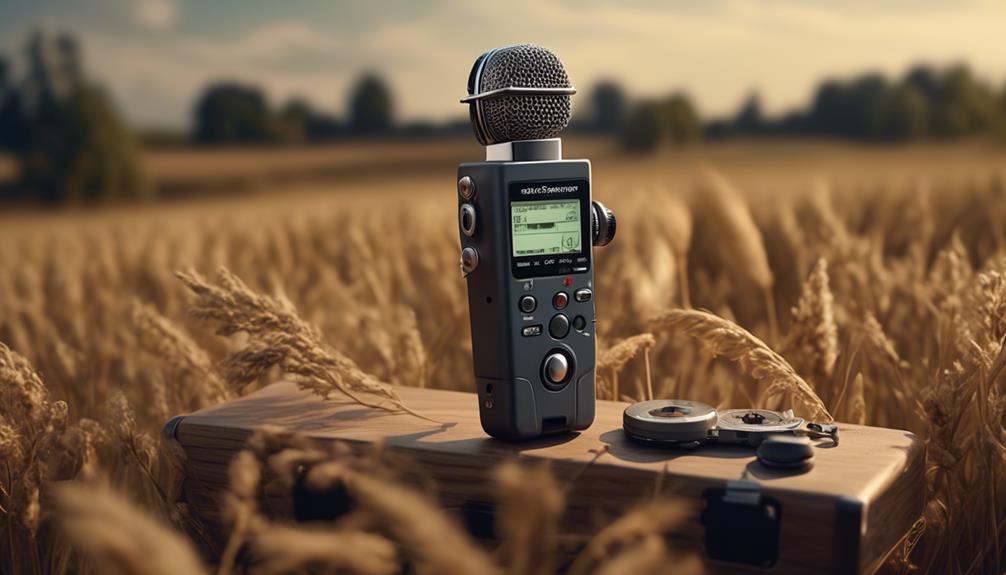
Selecting the right equipment for field recording involves carefully considering the environment and recording needs to ensure optimal audio capture. When it comes to field recording, the right gear can make all the difference. Here are some key considerations for selecting the right equipment:
- Audio Recorder: Look for a recorder with high-quality preamps, XLR inputs, and durable build to withstand the demands of field recording.
- Additional Microphones: Invest in external microphones to expand your recording capabilities and capture different sound perspectives, enhancing the richness of your recordings.
- Wind Protection: Use wind protection such as windshields and blimps to minimize wind noise and ensure clean, clear recordings.
- Microphone Techniques: Experiment with different microphone techniques such as A/B, M/S, XY, hydrophones, and contact mics to capture diverse sounds and add depth to your recordings.
- High-Quality Equipment: Prioritize high-quality equipment such as 24-bit WAV recorders with a sample rate of 44.1kHz for optimal field recordings, ensuring that you capture the nuances of the sound accurately.
Field recordists understand the importance of selecting the right equipment to achieve professional-grade recordings in diverse environments.
Recording Techniques and Tips
Exploring various recording techniques and tips can greatly enhance the quality and depth of field recordings. Achieving high-quality audio in field recording requires a combination of technical expertise and creative finesse. Understanding polar patterns and frequency response is essential for capturing nature sounds and other environmental elements effectively. Here are some recording techniques and tips to consider:
| Polar Patterns | Best Use |
|---|---|
| Cardioid | Versatile |
| Omnidirectional | Capturing ambience |
| Bidirectional | Interview settings |
| Frequency Response | Ideal Application |
| Flat | Natural sound reproduction |
| High-pass filter | Eliminating low-frequency rumble |
| Low-pass filter | Minimizing high-frequency noise |
| Additional Tips | |
| Experiment with microphone placement and distance. | |
| Pay attention to environmental factors such as wind and background noise. | |
| Consider sound design principles to enhance the emotional impact of the recording. | |
Location Scouting and Preparation
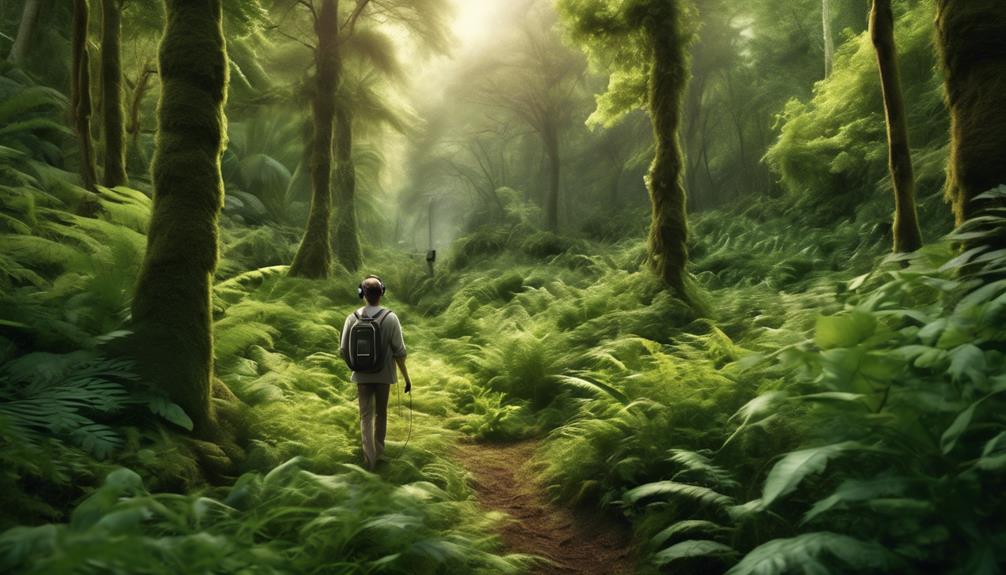
After conducting thorough research on potential recording locations, it's crucial to consider the time of day and weather conditions to capture a diverse range of environmental sounds. When preparing for field recording, we must keep in mind several key factors to ensure a successful and productive session:
- Research potential recording locations to ensure a variety of soundscapes.
- Consider the time of day and weather conditions to capture unique environmental sounds.
- Test recording equipment on-site to address any technical issues before the actual recording.
- Plan for mitigating unwanted environmental noise, such as wind or traffic, using appropriate gear and techniques.
- Ensure safety and legal compliance when accessing and recording in different locations.
Location scouting and preparation play a pivotal role in the outcome of our field recordings. It's essential to be well-prepared and equipped with the right tools, such as a wide stereo recorder and shock mounts, to capture high-quality sounds. Adhering to a comprehensive guide for location scouting and preparation ensures that we can effectively record the desired sounds while minimizing unwanted interference.
Editing and Enhancing Your Recordings
As we move from the crucial preparation of scouting and selecting recording locations, we now focus on the essential step of editing and enhancing our field recordings.
After capturing the raw sounds directly in front of us, the next phase involves refining and perfecting the audio. To begin, it's crucial to use a high-quality audio interface to pick up sounds accurately. Once the recordings are captured, it's time to dive into the world of editing and enhancing recordings.
Software like Adobe Audition serves as an invaluable tool for this purpose. We can edit the recordings, trim unnecessary parts, and arrange them to create a seamless and polished final product. Applying equalization (EQ) allows us to adjust the frequency balance and tone, while experimenting with compression helps to control the dynamic range, making the recordings sound more cohesive.
Furthermore, enhancing the recordings with reverb and other effects adds a sense of space and depth. Additionally, considering the technique of layering and blending multiple recordings can create a richer, more complex sonic landscape.
These steps are crucial in our pursuit of mastering the art of field recording.
Frequently Asked Questions
What Do You Need for Field Recording?
For field recording, we need recording equipment suitable for the field environment, capable of capturing various sound sources with precise microphone placement.
Noise reduction is crucial for pristine recordings, and editing software is essential for post-production.
Urban soundscape and wildlife recording require different approaches, so versatility is key.
Understanding these aspects and having the right gear ensures high-quality field recordings.
How Do I Learn Field Recording?
We learn field recording by immersing ourselves in diverse soundscapes. Experimenting with recording techniques, such as environmental and nature sounds, hones our skills. Perfecting microphone placement and sound editing refines our craft.
Our equipment setup evolves, enhancing our wildlife recordings and urban soundscape captures. As we master these elements, our field recording becomes an art, capturing the vibrant tapestry of the world around us.
What Is a Field Audio Recorder?
Field audio recorders, also known as portable recorders, are essential field recording equipment. They capture a wide range of sounds, including nature and city sounds. These devices feature built-in or external microphones for flexible sound capturing. They're crucial for outdoor recording, wildlife sounds, and urban exploration.
Proper microphone placement and remote recording techniques are essential for capturing authentic ambient sounds. Overall, field audio recorders are vital tools for creating immersive audio storytelling.
What Is the Best Sample Rate for Field Recording?
44.1kHz sample rate is the best choice for field recording. It captures a wide frequency range, preserving natural sound characteristics and ensuring high-quality playback. It balances quality and file size, allowing for manageable storage and editing without sacrificing audio fidelity. Additionally, it ensures compatibility with various recording devices and software, making it practical for capturing diverse environmental sounds.
When making wildlife recordings, equipment choices, location scouting, and weather considerations are crucial.
Conclusion
We learned how to make field recordings, and it's like capturing a moment in time. Just like a photographer captures a beautiful sunset, we capture the sounds of nature or the city.
With the right equipment and techniques, we can turn ordinary sounds into extraordinary audio experiences.
So next time you're out and about, don't forget to bring your recorder and capture the world around you. You never know what amazing sounds you might discover.



